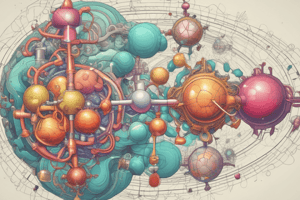Podcast
Questions and Answers
What is the term for the process by which small molecules are built up into larger ones in an organism?
What is the term for the process by which small molecules are built up into larger ones in an organism?
Anabolic reactions
What is the role of enzymes in metabolic reactions?
What is the role of enzymes in metabolic reactions?
To speed up the rate of chemical reactions within cells and remain unchanged
What is the term for a substance in food that is used for growth, repair, or maintaining the body?
What is the term for a substance in food that is used for growth, repair, or maintaining the body?
Nutrient
What is the characteristic of an enzyme that allows it to work on only one specific substrate?
What is the characteristic of an enzyme that allows it to work on only one specific substrate?
What is the term for molecules that have carbon chains, such as carbohydrates, amino acids, proteins, lipids, and nucleic acids?
What is the term for molecules that have carbon chains, such as carbohydrates, amino acids, proteins, lipids, and nucleic acids?
What is the term for the site on an enzyme where the substrate binds?
What is the term for the site on an enzyme where the substrate binds?
How does the induced fit model describe the binding of an enzyme and substrate?
How does the induced fit model describe the binding of an enzyme and substrate?
What happens to the active site of an enzyme when the pH changes?
What happens to the active site of an enzyme when the pH changes?
How does temperature affect enzyme activity?
How does temperature affect enzyme activity?
What happens to an enzyme when it is denatured?
What happens to an enzyme when it is denatured?
How does substrate concentration affect the rate of reaction?
How does substrate concentration affect the rate of reaction?
What is the primary source of energy in our diet that is broken down during cellular respiration to regenerate ATP?
What is the primary source of energy in our diet that is broken down during cellular respiration to regenerate ATP?
Study Notes
Metabolism
- Refers to all chemical reactions that occur within cells and organisms
- Comprises of two types: catabolic and anabolic reactions
- Catabolic reactions involve breaking down large molecules into smaller ones (e.g. digestion)
- Anabolic reactions involve building up small molecules into larger ones (e.g. protein synthesis)
Nutrients and Organic Compounds
- Nutrients are substances in food used for growth, repair, or maintaining the body
- There are six groups of nutrients: water, carbohydrates, lipids, proteins, minerals, and vitamins
- Organic compounds are large molecules that contain carbon chains (e.g. carbohydrates, amino acids, proteins, lipids, and nucleic acids)
- Inorganic compounds are small molecules that are not based on carbon chains (e.g. water, minerals, vitamins)
Enzymes
- Biological catalysts that speed up chemical reactions within cells without being consumed
- Made up of protein and are highly specific, with each enzyme only working on a specific substrate
- Lower the activation energy required for a reaction to occur
- Lock and Key Model: enzymes have an active site that matches the shape of their substrate
- Induced Fit Model: the shape of the enzyme changes when it binds to the substrate, creating a complementary shape
Factors Affecting Enzyme Activity
- pH: enzymes work best at a specific pH value, and changes in pH can alter the shape of the active site
- Temperature: enzymes work best at a comfortable temperature, and excessive heat can cause denaturation
- Substrate concentration: a limited concentration of substrate will limit the rate of reaction
- Enzyme concentration: a limited concentration of enzyme will also limit the rate of reaction
Cellular Respiration
- Metabolic process that breaks down food (e.g. glucose) to release energy
- Glucose is the primary source of energy in our diet, although amino acids and fatty acids can also be used
- ATP (adenosine triphosphate) is the energy currency of the cell, and is regenerated during cellular respiration
Studying That Suits You
Use AI to generate personalized quizzes and flashcards to suit your learning preferences.
Description
Learn about the chemical reactions of metabolism, including catabolic and anabolic reactions, and the 6 groups of nutrients required for growth and maintenance.




